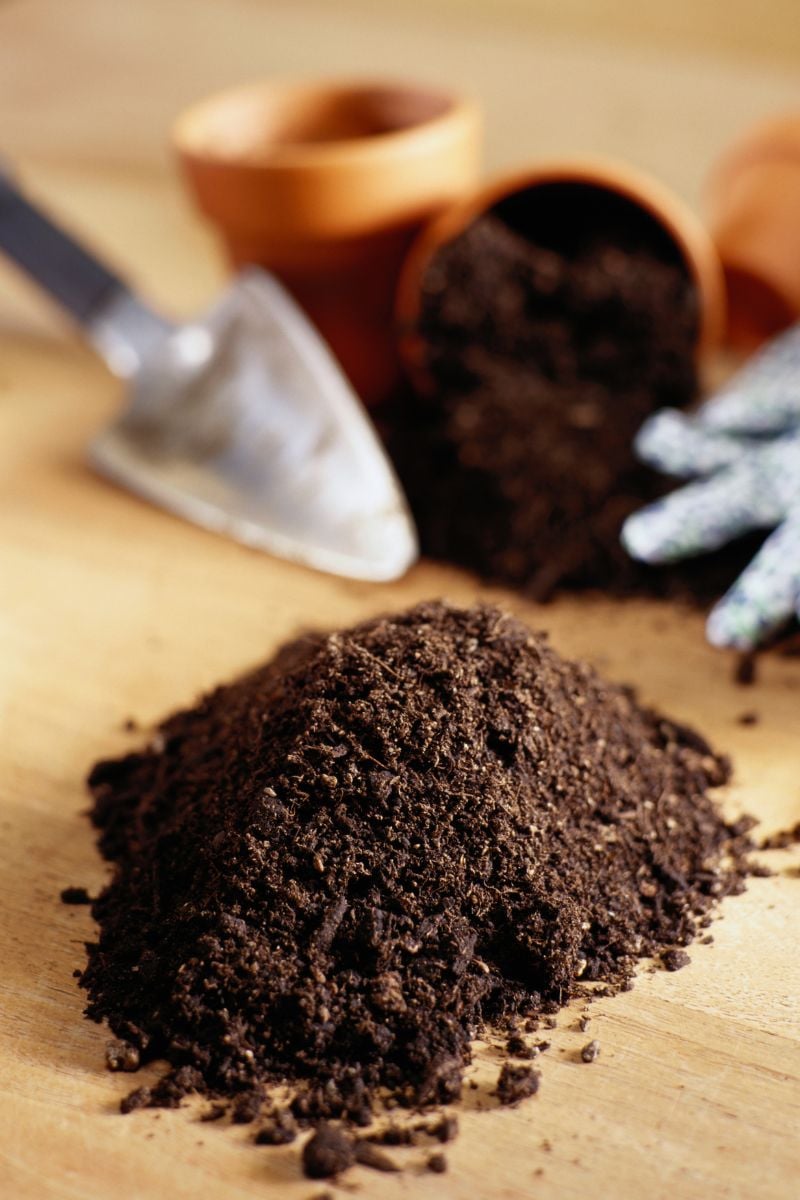Attention herb enthusiasts and DIY lovers! I'm excited share a project that combines style and functionality: hanging herb garden planters. These charming herb garden planters have found a home on our antique mantle-turned-kitchen shelf, but they're versatile enough for any sunny spot in your home.
Whether you're a seasoned gardener or just starting out, this project brings fresh herbs right to your fingertips. Using simple ceramic bowls and a few supplies, you can create a beautiful, space-saving herb garden that fits your personal style. Ready to grow your own herbs in style? Let's get started!

Content may contain affiliate links. When you shop the links, we receive a small commission at no cost to you. Thanks for supporting my small business.
Jump to:
Supplies for DIY hanging herb garden planters
Ready to create your own hanging herb garden? Let's gather the supplies! While I used Rae Dunn bowls for their charming style, don't worry if you can't find them. Any sturdy ceramic bowls around 6-8 inches in diameter will work beautifully. Here's everything you'll need to get started:
Ceramic bowls
- 4 Rae Dunn bowls or other ceramic bowls
Chains and hardware
- 1 pack of (12 strands of 16 links) small link chain
- 2 packs of suction cups with hooks
- 1 pk of black metal hooks
Tools and adhesives
- 1 pk of pliers (2 pliers required)
- 1 tape measure
- Sharpie marker
- 1 E6000 glue
Gardening supplies
- Potting soil suitable for herbs
- 4 - 4" potted herb plants or faux herb plants (or faux herbs for a low-maintenance option)
Optional extras
- Drainage material (pebbles or activated charcoal)
- Decorative moss for topping the soil

Choosing your herbs
Best herbs for container gardening:
Start with small plants or seedlings to give them room to grow in your planters. The following herbs thrive in small spaces. Perfect for this project!
- Basil
- Mint
- Thyme
- Rosemary
- Chives
- Parsley
Considerations for indoor herb gardens:
Ensure adequate sunlight (at least 6 hours daily), proper drainage, and avoid overwatering.
Suggested herb combinations:
- Mediterranean: basil, oregano, thyme
- Tea garden: mint, lemon balm
- Salad mix: parsley, chives, dill
Choose herbs with similar care requirements when planting together.
For more information on each of these herbs be sure to visit my sister site Celebrated Herb.

Step by step instructions
- Prepare chains:
Measure desired hanging length. Use pliers to create 12 equal-length chains (16 links each works well)

- Prepare bowl:
Mark 3 spots on the bowl's rim, 6" apart. Apply E6000 glue to attach suction cups at these marked spots. Let the glue set overnight to ensure a strong bond.

- Assemble planter:
Attach 3 chains to the hooks on each bowl.

- Planting preparation:
Add a layer of moist potting soil to the bowl. Remove the herb from its original pot and place it in the bowl. Fill around the plant with potting soil, leaving ¼" space at the top for watering.

- Choose herbs:
Use 4" potted herbs like oregano, parsley, rosemary, and sage or select your favorite herb varieties.

- Hang and enjoy:
Secure planters to your chosen location. Water and care for your new herb garden.

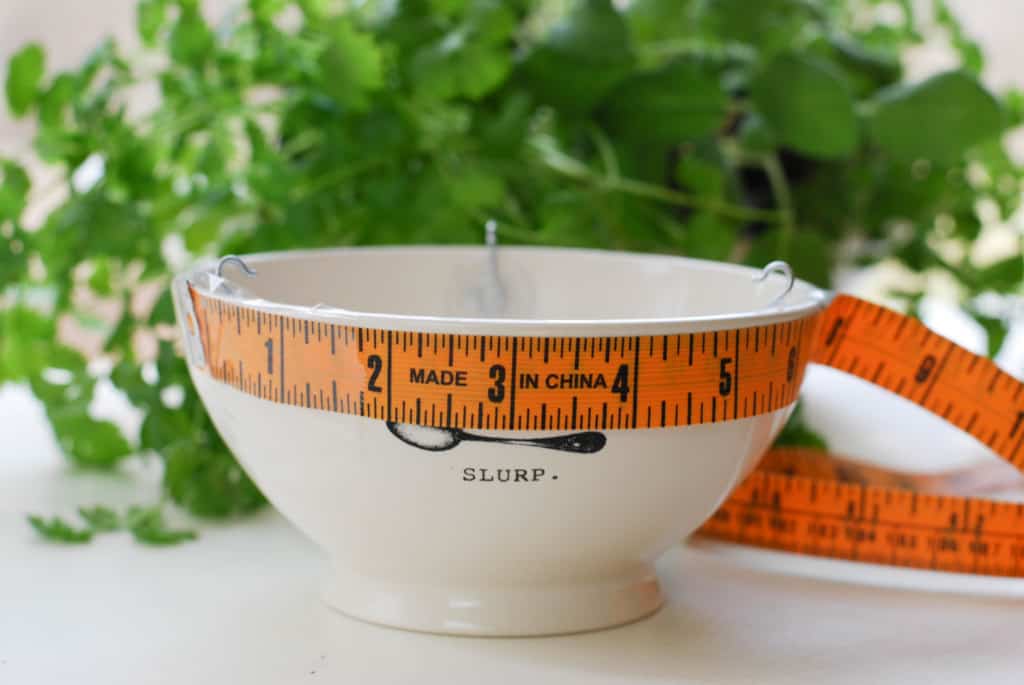
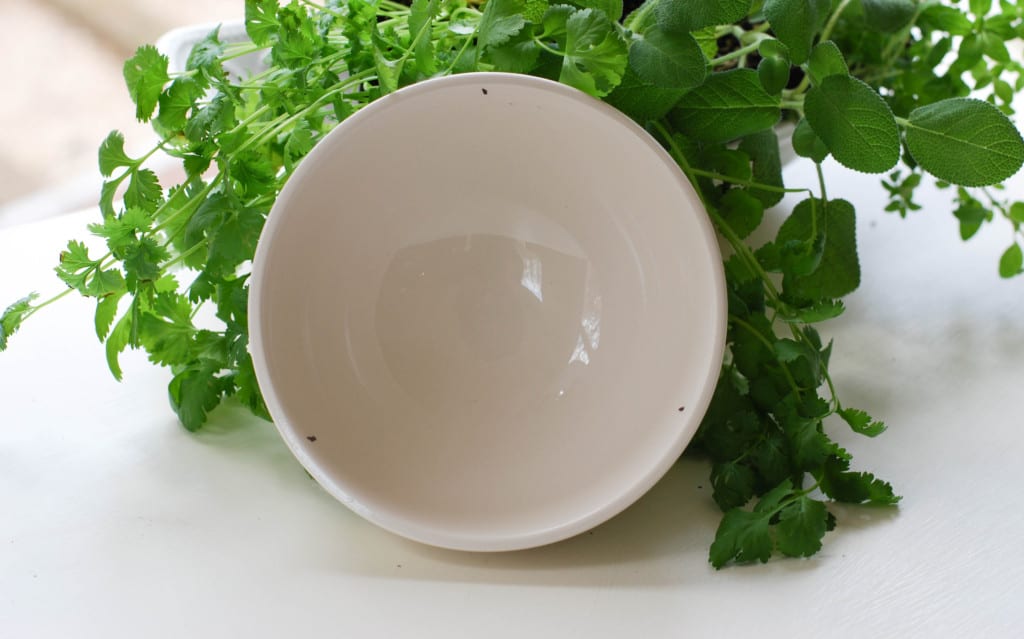
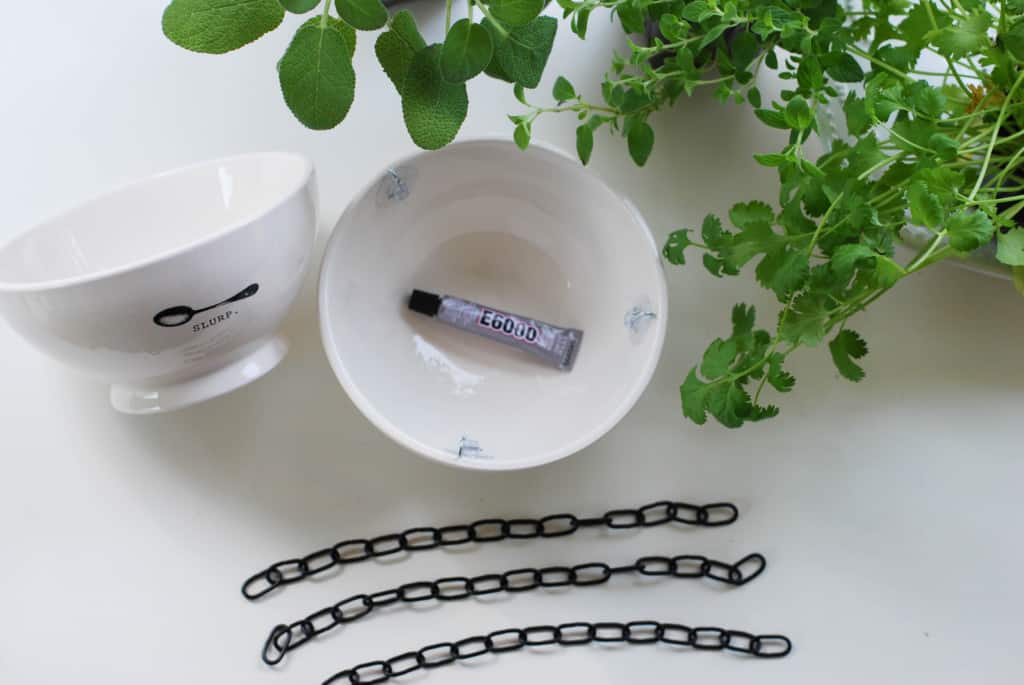
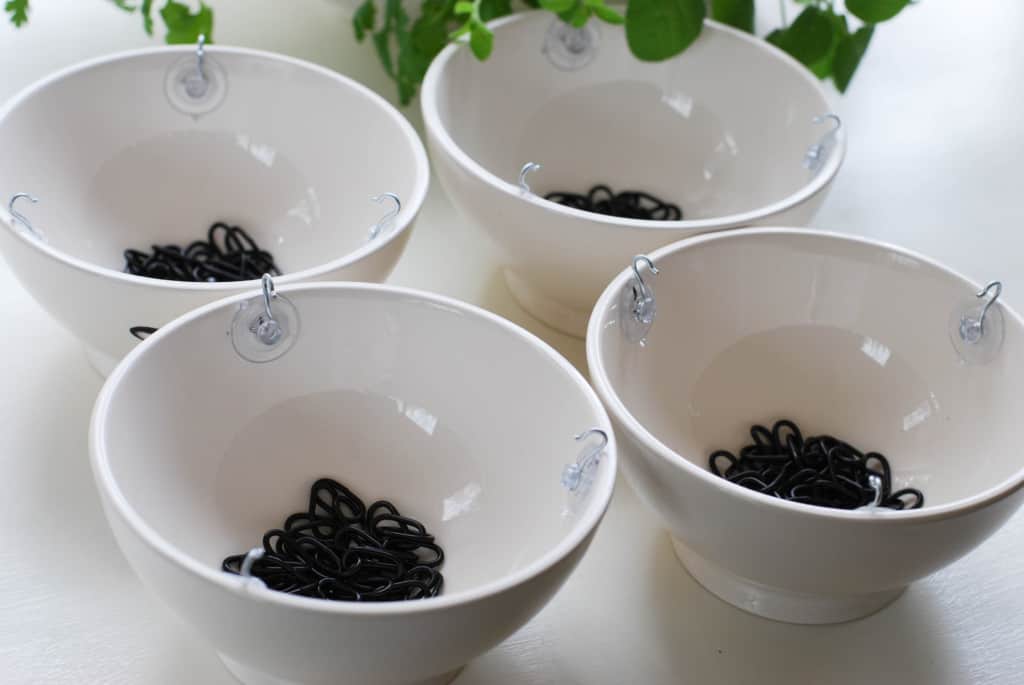
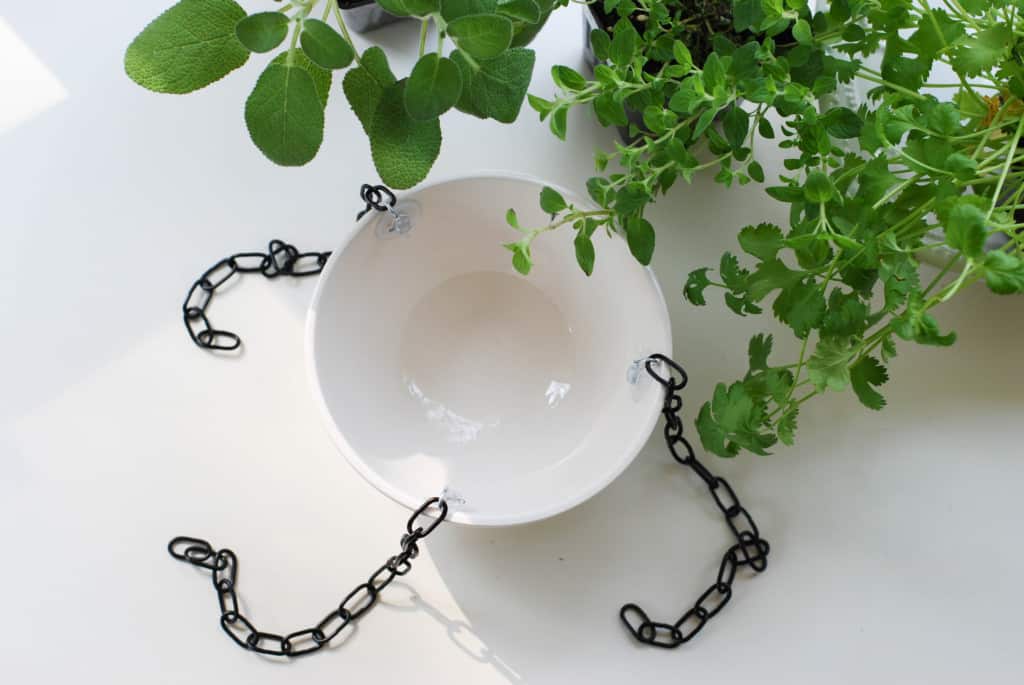

Hanging your planters
Now that your planters are ready, it's time to find them a home. Let's explore the best spots and methods for hanging your herb garden to ensure it thrives and adds beauty to your space.
Choosing the perfect spot
Kitchen Windowsill Options:
- South-facing windows offer the most light
- Use tension rods or adhesive hooks for easy installation
- Ensure planters don't interfere with opening/closing windows
Antique Mantle or Shelf Ideas:
- Repurpose an old mantle as a unique kitchen shelf
- Use decorative brackets for added support and style
- Mix herb planters with other decor for a balanced look
Outdoor Hanging Suggestions:
- Hang from porch ceilings or overhangs
- Use shepherd's hooks in garden beds or pots
- Consider a standing herb ladder for patios or balconies
Installation process
Using Hooks or Other Mounting Options:
- For mantles or shelves: Screw black metal hooks under the ledge
- For windows: Use strong tension rods or adhesive hooks
- For outdoor use: Consider weather-resistant hanging options
Ensuring Proper Support for the Weight:
- Use anchors when screwing hooks into drywall
- Check weight limits on adhesive hooks or tension rods
- Distribute weight evenly when using multiple planters
Hanging the Planters:
- Gather the 3 chains for each planter
- Loop the end link over the installed hook
- Adjust chain length as needed for desired height
Remember, proper installation is key to keeping your herb garden safe and accessible. Don't hesitate to ask for help when installing hooks or heavy planters.

Caring for your hanging herb garden
Now that your herb garden planters are assembled and hanging in their perfect spot, it's time to ensure your herbs thrive. Proper care will reward you with a bountiful harvest of fresh, flavorful herbs right at your fingertips. Here's everything you need to know to keep your hanging herb garden healthy and productive:
Watering tips
Proper Drainage Importance:
- Ensure planters have drainage holes
- Add a layer of pebbles at the bottom for extra drainage
- Use well-draining potting mix designed for herbs
Avoiding Overwatering:
- Check soil moisture before watering; only water when top inch feels dry
- Water thoroughly but less frequently
- Consider using a moisture meter for accuracy
Sunlight requirements
Finding the Right Balance:
- Most herbs need 6-8 hours of sunlight daily
- South-facing windows are ideal for indoor herbs
- Rotate planters regularly for even growth
Supplementing with Grow Lights if Needed:
- Use full-spectrum LED grow lights for low-light areas
- Position lights 6-12 inches above plants
- Provide 12-16 hours of artificial light daily if natural light is insufficient
Pruning and harvesting techniques
Regular Pruning:
- Pinch off tips of herbs regularly to encourage bushier growth
- Remove any dead or yellowing leaves promptly
Proper Harvesting:
- Harvest in the morning after dew has dried for best flavor
- Cut stems just above a leaf intersection
- Never remove more than ⅓ of the plant at once
Continuous Care:
- Fertilize monthly with a balanced, water-soluble fertilizer
- Watch for pests and treat promptly with neem oil or insecticidal soap
- Replant annual herbs as needed, typically every few months
Remember, each herb may have slightly different care requirements. Adjust your care routine based on the specific needs of your chosen herbs and the conditions in your home.

Troubleshooting and maintenance
Even with the best care, herb gardens can sometimes face challenges. Let's explore common issues and how to keep your hanging herb garden thriving year-round.
Common issues with hanging herb gardens
- Yellowing leaves: Often a sign of overwatering or poor drainage
- Leggy growth: Indicates insufficient light
- Pest infestations: Look for signs of aphids, spider mites, or whiteflies
- Wilting: Could be under-watering or root rot from overwatering
- Stunted growth: Might be due to nutrient deficiency or rootbound plants
Seasonal care tips
- Spring: Prune dead growth, fertilize, and consider replanting annuals
- Summer: Increase watering frequency, protect from intense afternoon sun
- Fall: Reduce watering and fertilizing as growth slows
- Winter: Provide extra light, maintain humidity, and protect from cold drafts
Replacing or refreshing plants
- Rotate annual herbs every few months for continuous harvest
- Divide and repot perennial herbs annually to prevent overcrowding
- Refresh soil yearly with new potting mix to replenish nutrients
- Replace any plants that have become woody or unproductive
Remember, regular observation is key to catching and addressing issues early!
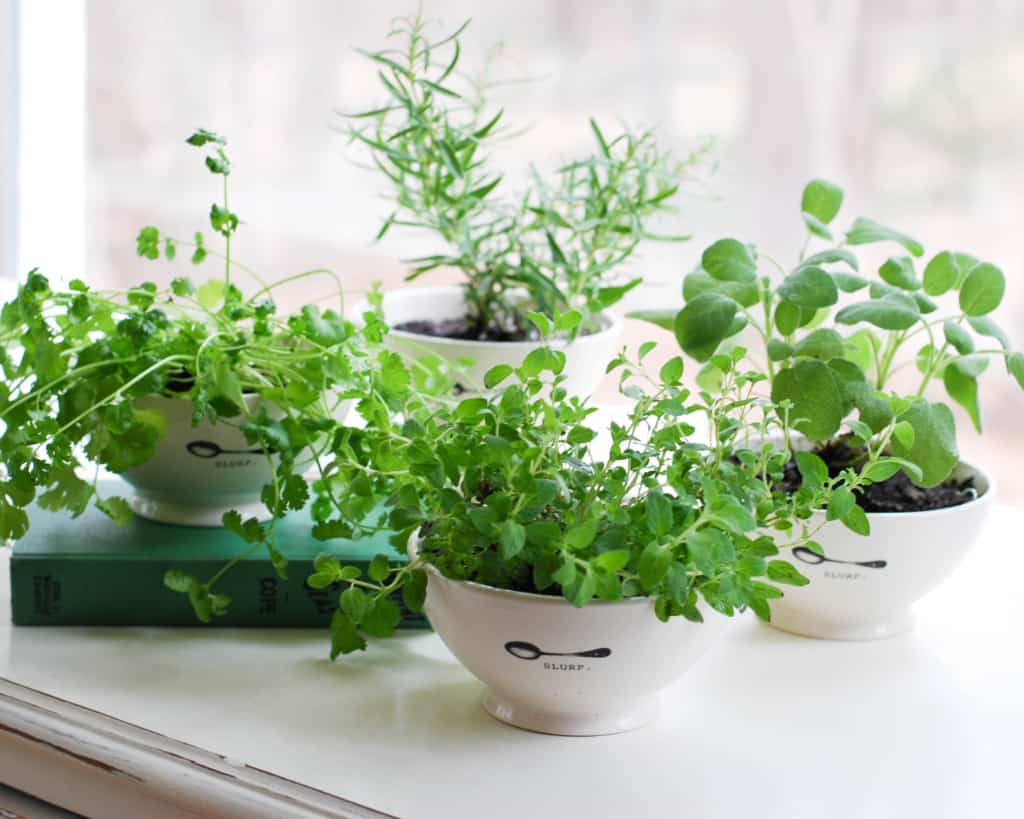
Alternative ideas and variations
Your hanging herb garden can be customized to fit your unique needs and space. Let's explore some creative variations and adaptations to make this project truly your own.
Using faux Hherbs for a low-maintenance option
- Benefits: No watering or sunlight needed, always looks fresh
- Choosing realistic faux herbs: Look for varied leaf sizes and natural colors
- Mixing real and faux: Combine low-maintenance faux with a few live herbs
- Care tips: Dust regularly and refresh arrangement seasonally
Adapting the project for outdoor use
- Choose weather-resistant containers: Ceramic, metal, or plastic
- Use sturdy mounting hardware to withstand wind and rain
- Select outdoor-friendly herbs: Rosemary, thyme, and oregano are hardy options
- Consider seasonal changes: Protect or bring plants indoors during harsh weather
Scaling the project for larger or smaller spaces
- Tiny spaces: Use miniature herbs in small pots on a window ledge
- Balconies: Create a herb wall with multiple hanging planters
- Large kitchens: Expand to a full herb garden with varied container sizes
- Outdoor areas: Combine hanging planters with standing herb gardens
Remember, the key is to adapt the project to fit your space and lifestyle while maintaining the charm of fresh herbs at your fingertips!

Creating your own hanging herb garden planters is the perfect solution for bringing the joys of indoor gardening to your home, regardless of how much space you have. Whether you choose to hang your herb containers in a sunny window, on your kitchen windowsill, or in a small outdoor space, you're on your way to having your own fresh herbs at your fingertips.
Remember, the key to a thriving indoor herb garden is choosing the right containers with good drainage, ensuring your plants get enough hours of sun (or supplementing with a grow light), and practicing proper watering techniques. With a little care and attention, even those without a green thumb can successfully grow a variety of herbs in small spaces.
From compact basil plants to Mediterranean herbs, your container herb garden will not only add a touch of green to your living room or patio area but also elevate your culinary experiences. Say goodbye to store-bought herbs and hello to the satisfaction of snipping your favorite herbs from your very own beautiful planters.
So why wait? Start your DIY herb garden project today and enjoy the full potential of fresh, homegrown herbs in your own kitchen.
Happy planting friends!





